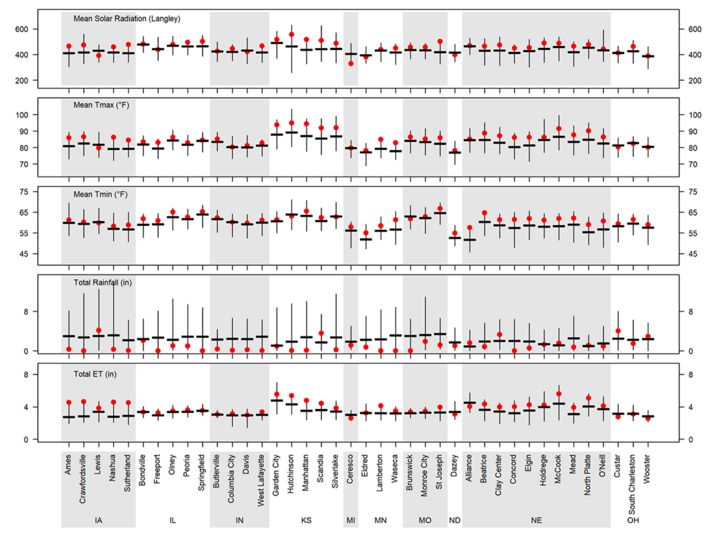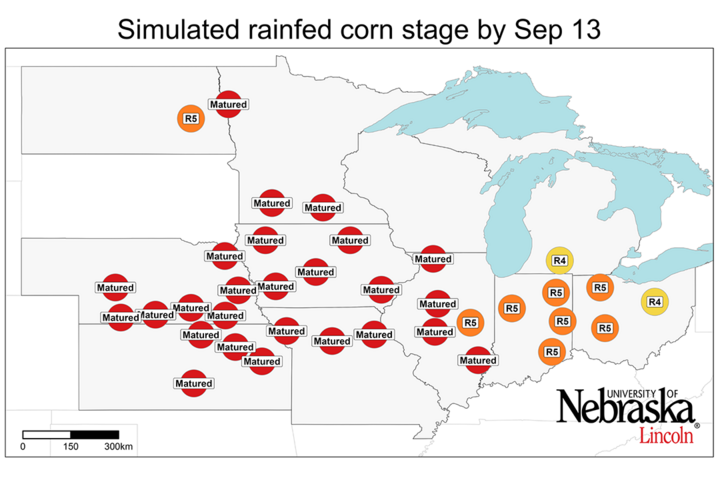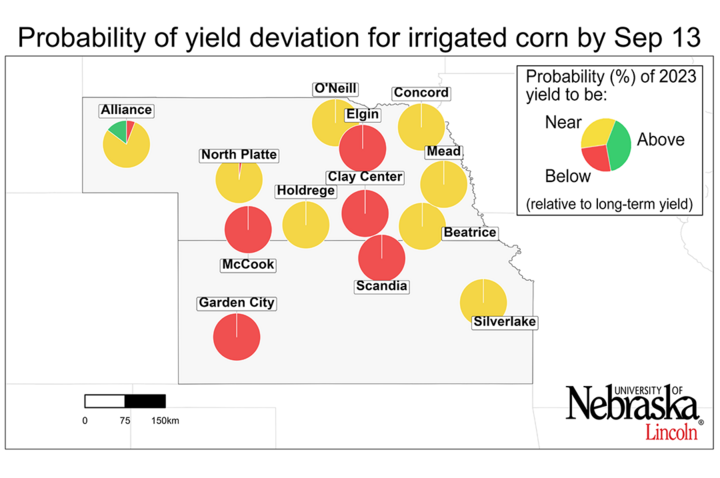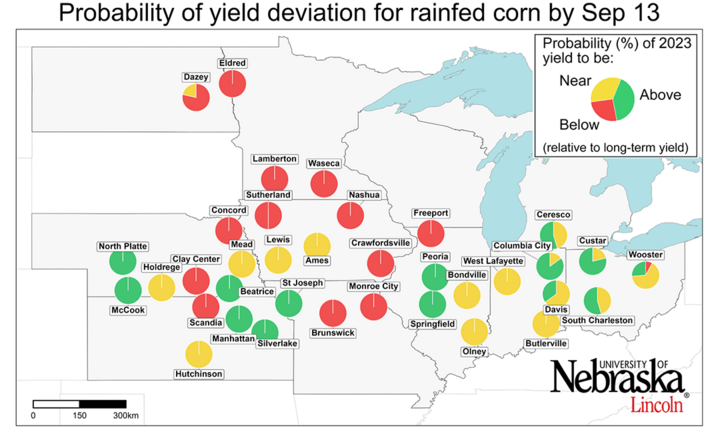This is the last article in a series that summarizes the simulated crop stages and yield forecasts across the Corn Belt. To evaluate, in “real-time,” the impact of this season’s weather on corn yield and its spatial variability across the Corn Belt, simulations of 2023 real-time crop stage were performed for 40 locations across the U.S. Corn Belt using the UNL Hybrid-Maize crop model; the data can be seen in Table 1. Details on the UNL Hybrid-Maize crop model and the underpinning methodology to simulate phenology and forecast end-of-season yields is described in a previous article.

Table 1. Data from simulations of 2023 end-of-season corn yield potential and real-time crop stage performed on Sept. 13.
| Location | Water regime | Long-term average yield (bu/ac) § | Range of Yp forecasts as of Sept. 13 (bu/ac)¶ 25th | Range of Yp forecasts as of Sept. 13 (bu/ac)¶ 75th | Probability (%) of 2022 yield to be: Below (relative to the long-term Yp)† | Probability (%) of 2023 yield to be: Near (relative to the long-term Yp)† | Probability (%) of 2023 yield to be: Above (relative to the long-term Yp)† | Simulated current crop stage* | |
|---|---|---|---|---|---|---|---|---|---|
| NE | Alliance | Irrigated | 193 | 196 | 209 | 6% | 79% | 15% | R5, Dent |
| Beatrice | Dryland | 160 | Black layer on Aug. 28. Final yield: 187 bu/ac | Matured | |||||
| Irrigated | 229 | Black layer on Aug. 29. Final yield: 212 bu/ac | Matured | ||||||
| Clay Center | Dryland | 155 | Black layer on Sept. 2. Final yield: 100 bu/ac | Matured | |||||
| Irrigated | 245 | Black layer on Sept. 5. Final yield: 217 bu/ac | Matured | ||||||
| Concord | Dryland | 173 | Black layer on Aug. 31. Final yield: 122 bu/ac | Matured | |||||
| Irrigated | 248 | Black layer on Sept. 8. Final yield: 229 bu/ac | Matured | ||||||
| Elgin | Irrigated | 252 | Black layer on Sept. 6. Final yield: 225 bu/ac | Matured | |||||
| Holdrege | Dryland | 112 | Black layer on Sept. 1. Final yield: 116 bu/ac | Matured | |||||
| Irrigated | 242 | 233 | 236 | 0% | 100% | 0% | R5, Dent | ||
| McCook | Dryland | 86 | Black layer on Aug. 27. Final yield: 99 bu/ac | Matured | |||||
| Irrigated | 224 | Black layer on Aug. 31. Final yield: 201 bu/ac | Matured | ||||||
| Mead | Dryland | 181 | Black layer on Sept. 2. Final yield: 196 bu/ac | Matured | |||||
| Irrigated | 234 | Black layer on Sept. 1. Final yield: 221 bu/ac | Matured | ||||||
| North Platte | Dryland | 90 | Black layer on Sept. 6. Final yield: 113 bu/ac | Matured | |||||
| Irrigated | 234 | 213 | 220 | 2% | 98% | 0% | R5, Dent | ||
| O'Neill | Irrigated | 226 | 221 | 226 | 0% | 100% | 0% | R5, Dent | |
| IA | Ames | Dryland | 228 | Black layer on Sept. 3. Final yield: 206 bu/ac | Matured | ||||
| Crawfordsville | Dryland | 227 | Black layer on Sept. 1. Final yield: 154 bu/ac | Matured | |||||
| Lewis | Dryland | 205 | Black layer on Aug. 31. Final yield: 214 bu/ac | Matured | |||||
| Nashua | Dryland | 228 | Black layer on Sept. 2. Final yield: 153 bu/ac | Matured | |||||
| Sutherland | Dryland | 208 | Black layer on Sept. 6. Final yield: 171 bu/ac | Matured | |||||
| IL | Bondville | Dryland | 235 | 235 | 238 | 0% | 100% | 0% | R5, Dent |
| Freeport | Dryland | 213 | Black layer on Sept. 6. Final yield: 184 bu/ac | Matured | |||||
| Olney | Dryland | 191 | Black layer on Aug. 26. Final yield: 202 bu/ac | Matured | |||||
| Peoria | Dryland | 211 | Black layer on Sept. 9. Final yield: 242 bu/ac | Matured | |||||
| Springfield | Dryland | 182 | Black layer on Aug. 29. Final yield: 220 bu/ac | Matured | |||||
| IN | Butlerville | Dryland | 224 | 221 | 221 | 0% | 100% | 0% | R5, Dent |
| Columbia City | Dryland | 224 | 250 | 274 | 0% | 15% | 85% | R5, Dent | |
| Davis | Dryland | 230 | 239 | 256 | 0% | 65% | 35% | R5, Dent | |
| West Lafayette | Dryland | 236 | 236 | 243 | 0% | 100% | 0% | R5, Dent | |
| KS | Garden City | Irrigated | 217 | Black layer on Aug. 31. Final yield: 193 bu/ac | Matured | ||||
| Hutchinson | Dryland | 99 | Black layer on Aug. 10. Final yield: 97 bu/ac | Matured | |||||
| Manhattan | Dryland | 137 | Black layer on Aug. 16. Final yield: 160 bu/ac | Matured | |||||
| Scandia | Dryland | 129 | Black layer on Aug. 21. Final yield: 95 bu/ac | Matured | |||||
| Irrigated | 226 | Black layer on Aug. 24. Final yield: 190 bu/ac | Matured | ||||||
| Silverlake | Dryland | 141 | Black layer on Aug. 18. Final yield: 164 bu/ac | Matured | |||||
| Irrigated | 209 | Black layer on Aug. 22. Final yield: 210 bu/ac | Matured | ||||||
| MI | Ceresco | Dryland | 180 | 180 | 208 | 0% | 45% | 55% | R4, Dough |
| MN | Eldred | Dryland | 114 | Black layer on Sept. 6. Final yield: 83 bu/ac | Matured | ||||
| Lamberton | Dryland | 212 | Black layer on Sept. 1. Final yield: 169 bu/ac | Matured | |||||
| Waseca | Dryland | 219 | Black layer on Sept. 4. Final yield: 176 bu/ac | Matured | |||||
| MO | Brunswick | Dryland | 181 | Black layer on Aug. 27. Final yield: 93 bu/ac | Matured | ||||
| Monroe City | Dryland | 175 | Black layer on Aug. 27. Final yield: 131 bu/ac | Matured | |||||
| St. Joseph | Dryland | 169 | Black layer on Aug. 24. Final yield: 199 bu/ac | Matured | |||||
| ND | Dazey | Dryland | 108 | 94 | 97 | 79% | 21% | 0% | R5, Dent |
| OH | Custar | Dryland | 208 | 229 | 255 | 0% | 21% | 79% | R5, Dent |
| South Charleston | Dryland | 216 | 235 | 248 | 0% | 45% | 55% | R5, Dent | |
| Wooster | Dryland | 210 | 197 | 231 | 8% | 66% | 26% | R4, Dough | |
§Long-term (last 20-plus years) potential yield at each location and surrounding area.
¶ Range of forecasted 2023 potential yields based on average planting date in 2023, indicating the potential yields in the 25th and 75th percentile of the potential yield distribution (associated with respective adverse and favorable weather scenarios during the rest of the season).
† Probability of obtaining a 2023 yield below (10%) than the long-term potential yield at each location.
Crop Stages and Weather Conditions During the Last Three Weeks
Corn has reached black layer stage at most of the sites, except for those located in western and eastern fringes of the region, including ND, western NE, IN and OH (Figure 2). During the late grain filling, temperature was above normal and rainfall below normal, except for the eastern region where temperature and rainfall were near average (IN and OH). Indeed, several sites across IN, IL, IA, MN and KS received very little or no rainfall during this period.
A summary of weather conditions during the past three weeks is shown in Figure 1.


Near but Below Average Yields in Irrigated Corn
Forecasted end-of-season irrigated yields are shown in Figure 3 and 4. About two thirds of the irrigated sites (eight out of 13) exhibited near-average yields. Compared with our previous forecast, forecasted yields are 7% lower because of higher temperatures during the last half of the grain filling. Although most irrigated sites present forecasted yields near historical records, expected yields are consistently lower than historical averages (average: 8% lower) and similar to the previous (2022) season.
Rainfed Corn: Yield Potential is Highly Variable Across Rainfed Sites
Lack of rainfall and high temperatures during the last portion of the seed filling led to a reduction of the projected end-of-season rainfed yields by nearly 5% compared to our previous forecast. Still, one-third (10 out of 36) of the sites are expected to achieve above-average yields. These sites are scattered across the region, including portions of western NE, northeast KS, southeastern NE, northwestern MO, IL, IN and OH (Figures 3 and 4).
Conversely, another third of the sites (13 out of 36) exhibit below-average yields. These sites are situated in the central and western areas of the Corn Belt (eastern IA, northwestern IL, northern MO, northeastern and south-central NE, north-central KS) and the northwestern region (north of IA, MN and ND).
The remaining sites showed a high probability of near-average yield and are located in the eastern part of the Corn Belt (eastern IL, IN and OH, and southern IA).
Overall, the 2023 yield scenario appears to be slightly more favorable than the previous year (2022) but is still 6% below the long-term average. Compared to the 2022 season, forecasted yield is higher for the current 2023 season for rainfed sites in NE, southwestern IA and southern KS. Conversely, 15% or more lower yield is forecasted for southern MN, northeastern IA, and MO compared with the previous year.




Conclusions
Aggregated at regional level, our forecasted yield potential this season is 7% below the historical average for both rainfed and irrigated corn. In line with USDA predictions, our forecast reduced expected yields compared to the August report and foresees similar average yield compared to that from last year.
Our forecast suggests a near average year for a majority of irrigated sites although 40% of them can expect yields to be below the historical average.
For rainfed corn, the scenario is diverse across regions. Most sites in the eastern part of the Corn Belt and a few scattered sites in central and western areas have a high probability of near-average rainfed yields. Above-average yield is expected at 10 locations scattered across the west and eastern areas of the Corn Belt. Conversely, 13 sites located in central, western and northwestern fringes of the Corn Belt exhibit a high probability of below-average rainfed yields.
Note that these forecasts do not take into consideration problems with stand emergence, hail/flooding damage, replanting situations, disease or nitrate leaching. In fields negatively affected by these constraints, actual yields will be lower than estimates provided here.
It is important to keep in mind that yield forecasts are not field specific and, instead, represent an estimate of average on-farm yield for a given location and surrounding area in absence of the yield-reducing factors mentioned here. Likewise, crop stages and forecasted yields will deviate from those reported here in fields with planting dates or hybrid maturities that differ markedly from those used as the basis for these forecasts.
